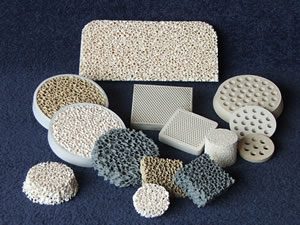Honeycomb ceramics for dross removal and metal filtration applications

Honeycomb ceramics are applied as heat storage media in regenerative thermal processes to recover thermal energy.
Typical ceramic filtration application examples are thermal air pollution abatement systems, based on regenerative thermal oxidation (RTO), thermal regenerators for process gases, heat storage media for decentralized Regenerative Housing Ventilation systems (RHV) or heat storage applications in renewable energy generation systems.
The main area of application for honeycomb ceramics are still RTOs for destruction of Volatile Organic Compounds (VOCs).
Typical industries that use such regenerative thermal oxidation systems include the pharmaceutical and chemical industries, paint and paper manufacturers, wood processing companies, and the electronics and semiconductor industries amongst others.
The most important advantage of the structured packing using honeycomb ceramics – when compared to conventional random packing technologies (ceramic saddles or plates) – is the highest possible heat recovery at the lowest possible pressure drop. Defined linear flow prevents particle deposits and chemical attacks. Simple operation and very low operating and maintenance costs make such honeycomb regenerator systems an extremely reliable and economically efficient solution.
Regenerator beds in regenerative thermal oxidation systems have to meet many requirements under often very drastic conditions. The properties of honeycomb ceramics must therefore be tailored to different requirements. For this reason, an optimized material was developed for every application. The right combination of the different materials within a heat storage bed will lead to an optimum result.